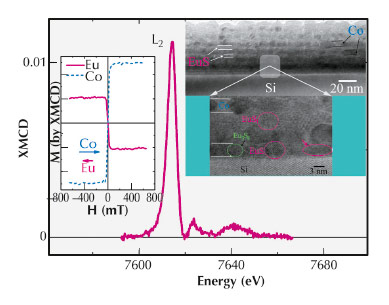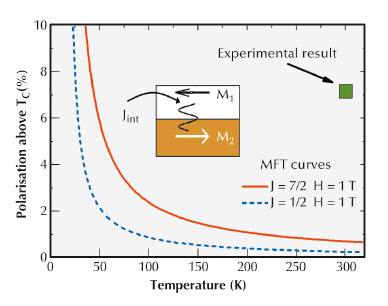- Home
- Users & Science
- Scientific Documentation
- ESRF Highlights
- ESRF Highlights 2013
- Electronic structure and magnetism
- Direct evidence for significant spin-polarisation of EuS in Co/EuS multilayers at room temperature
Direct evidence for significant spin-polarisation of EuS in Co/EuS multilayers at room temperature
Materials for spintronic applications need to have both magnetic and semiconducting properties. However, an intrinsic semiconductor which is magnetic at room temperature has yet to be found. The europium chalcogenides (EuO, EuS, EuSe, EuTe) are promising wide band-gap semiconductors, but they have very low Curie temperatures. Here, for the first time, we provide clear evidence that EuS layers can be spin-polarised at room temperature in proximity to a ferromagnet, such as Co, using XMCD at the Eu-L2,3 edges. Therefore, manipulation of the electron spin and charge in these materials should be feasible in the near future.
Most work in the literature has focused on diluted magnetic semiconductors. However, earlier measurements carried out at beamline ID12 proved that there is no sign of intrinsic ferromagnetic interaction between Co substitution (dopant) ions in ZnO in diluted semiconductors. The Co ions showed purely paramagnetic or superparamagnetic response [1].
In this work, Co/EuS multilayers were prepared by e-beam evaporation in ultrahigh vacuum. High-resolution cross-section transmission electron microscopy showed good quality of layering (see right inset of Figure 104 for a Co (4 nm)/EuS (3.5 nm) multilayer). However, defects resulted in a partial loss of stoichiometry and the appearance of both, divalent and trivalent Eu. Only divalent Eu contributes to ferromagnetism while the trivalent Europium possesses J = 0.
 |
|
Fig. 104: R.T. spin polarisation of Eu in EuS layers in proximity to Co. Inset: element-specific hysteresis loops are traced for both, Co and EuS, at R.T. The cross-section transmission electron microscopy images support the successful formation of the Co/EuS multilayers. A few Eu3S4 crystallites are also visible. (We thank Dr. A. Delimitis for the microscopy images.) |
Element-specific XMCD measurements were performed at the L2,3 edges of Eu at beamline ID12 at temperatures between R.T. and 2.5 K and under fields as large as 17 T. Figure 104 shows a clear XMCD signal at the L2 edge of Eu recorded on a Co (7 nm)/EuS (2 nm) multilayer at R.T. Comparison with the low temperature (T = 2.5 K) XMCD signal leads to the conclusion that divalent Eu shows a relatively large magnetic response at R.T. (magnetic moment per ion surprisingly similar to the one of bulk Ni). Element-specific hysteresis loops at R.T. (inset) showed that there is no need of an external field to spin polarise EuS, so this is an effect of the direct exchange coupling Jint at the interface with Co. We also observe that the Co and Eu moments are always antiparallel. No significant change of the magnitude of the magnetisation of each element occurs up to 0.65 T.
Mainly two parameters may have led to the strong magnetic response of EuS at R.T. First, EuS layers are very susceptible to effective fields due to the J = 7/2 character of the system. In Figure 105, we show that the same effective field, in a mean-field theory (MFT) approach, polarises a J = 7/2 system almost by a factor of three more than a J = 1/2 system at the same reduced temperature above TC. Secondly, in this work, we used very thin layers approaching the two dimensional-limit (2 nm of EuS correspond to about 6 atomic (100) planes). Two-dimensional ferromagnets are not stable against thermal fluctuations at finite temperatures. However, even moderate fields are able to suppress the spin fluctuations and result in significant TC enhancement of ultrathin ferromagnetic films. Similarly in exchange coupled layers, like Co and EuS, the exchange coupling at the interface plays the role of an effective field of the order of 1 T. Interestingly, a MFT without taking into account the presence of two-dimensional magnetic fluctuations in ultrathin films would underestimate substantially (even by one order of magnitude) the TC enhancement in these layers.
 |
|
Fig. 105: MFT curves show that a J = 7/2 system is more susceptible than a J = 1/2 system for moderate effective fields at the same reduced temperature t = T/TC; (here TC is supposed to be 16.6 K in both calculations, therefore, t scales as T). However, the strong spin polarisation of the 2 nm EuS by Co cannot be understood by MFT. The reduced dimensionality of EuS layers may provide a more plausible explanation. |
In conclusion, here we show promising employment of Co/EuS or similar layered structures in spintronics. The R.T. ferromagnetism in combination with tuneable optical properties of very thin EuS layers, due to quantum confinement effects, may render EuS-based layered structures useful for novel optoelectronics-spintronics applications [2].
Principal publication and authors
S.D. Pappas (a), P. Poulopoulos (a,b), B. Lewitz (b), A. Straub (b), A. Goschew (b), V. Kapaklis (c), F. Wilhelm (d), A. Rogalev (d) and P. Fumagalli (b), Scientific Reports 3, 1333 (2013).
(a) University of Patras (Greece)
(b) Freie Universität Berlin (Germany)
(c) Uppsala University (Sweden)
(d) ESRF
References
[1] A. Ney et al., PRL 100, 157201 (2008).
[2] S.D. Pappas et al., Scientific Reports 3, 1333 (2013).



